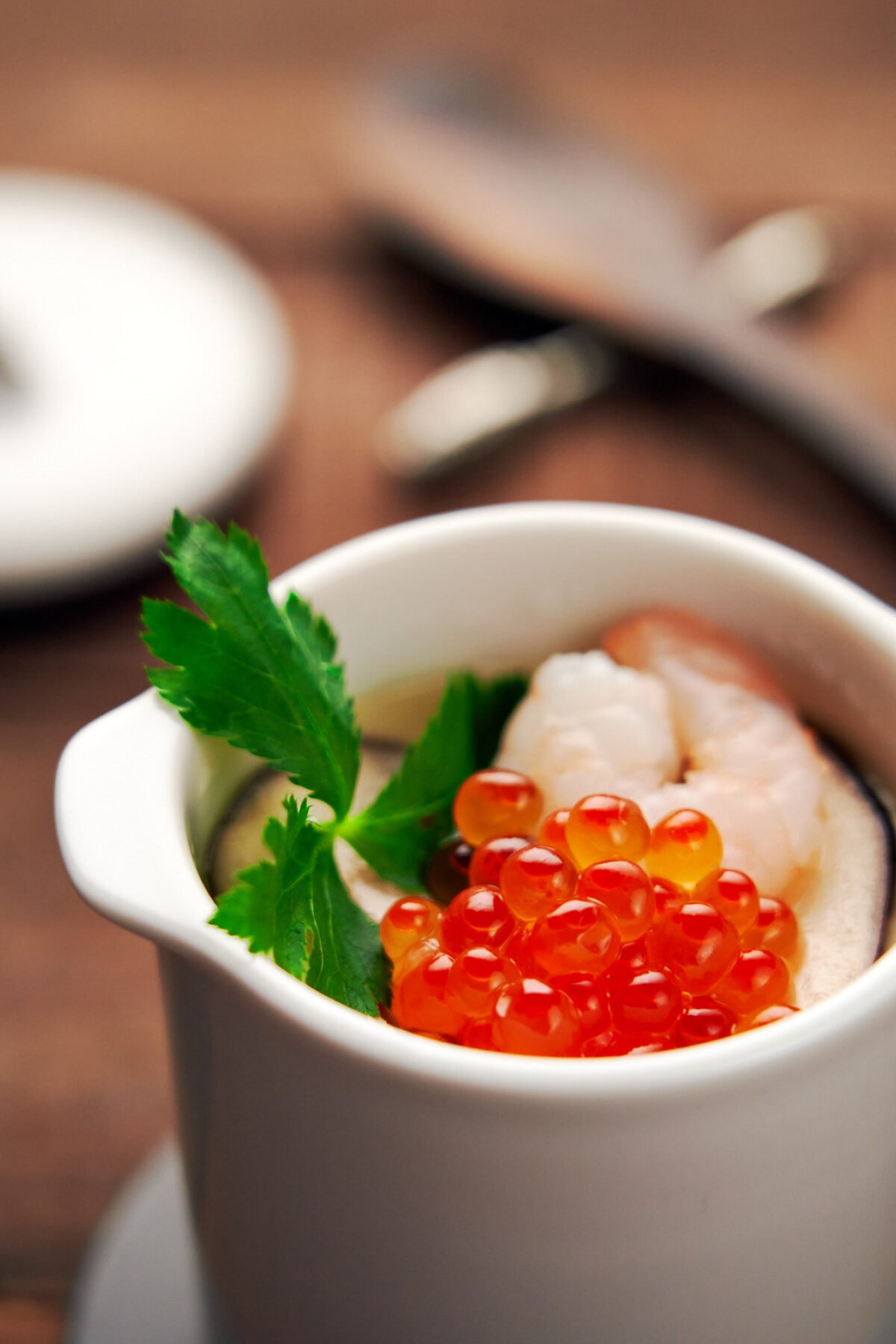
Chawanmushi
Chawanmushi (茶碗蒸し) is a silky smooth Japanese steamed egg custard that was originally served as a type of soup. This is why it has a very high ratio of soup stock to egg, and the custard usually has a variety of seafood, mushrooms, and vegetables cooked together with it. The dish is as simple as mixing egg and stock and adding in some mix-ins before steaming the mixture in cups; however, there are a few critical techniques to ensure you get the right consistency.
Jump to:
Why this recipe works
- As long as you remember the 3:1 ratio of soup stock to egg, you can make this chawanmushi recipe from any combination of ingredients.
- Taking care not to incorporate air into the custard mixture, and removing any bubbles that float to the surface is the key to making a smooth chawanmushi.
- Steaming the cups on a dish towel in a water bath allows the custard to cook through slowly, giving it a satiny texture.

Ingredients for Chawanmushi
- Stock - The flavor of the chawanmushi comes from the stock, which is why it's essential to use a high-quality one. Traditionally chawanmushi is made with dashi, which is a Japanese soup stock made from katsuobushi and konbu. Still, this steamed egg works with any flavorful stock such as chicken stock or mushroom stock.
- Egg - The egg is what turns the stock into a custard. For chawanmushi, you want to use a 3:1 ratio of stock to egg. So, for example, if you have 1 ½ cups of stock, you'd need to add ½ cup of egg.
- Seasoning - I kept this chawanmushi recipe simple and just used salt (along with the stock) to season the custard, but there are many options here, including soy sauce. Just be aware that if you choose to use soy sauce, the color of your custard will turn brown.
- Mix-Ins - The sky's the limit in terms of things that you can add to this steamed egg. Traditional ingredients include chicken, shrimp, crab, ginkgo nuts, mushrooms, and kamaboko (fish cake), but there's so much room for improvisation. Generally, you want to think about mix-ins in three categories: 1) flavor - ingredients with a lot of umami like meat, fish, and mushrooms 2) texture - ingredients that will give a contrasting texture to the silky custard such as edamame, shrimp, or water chestnuts 3) color - colorful elements make your chawanmushi fun to eat, and can include things like kamaboko and greens.
- Toppings - Toppings aren't necessary, but they add a splash of color on top, and you can add ingredients that you either don't want cook (like ikura, uni, or shaved truffles), or that you want to precisely control the cooking time for (like carrots, or shrimp).
How to make Chawanmushi
The first thing you need to do is make the custard by mixing the eggs, stock, and salt. I usually like to beat the eggs separately to ensure they are evenly mixed before adding the stock and salt.
It's also very important to try and limit the amount of air you beat into it. I've found that using chopsticks held vertically with a side-to-side (as opposed to circular) motion works best. You will inevitably end up with some air bubbles in your finished mixture, which will eventually pop if you let the mixture rest. If you are in a hurry, you can use a mesh skimmer to remove the foam from the surface.
Then the mixture should be strained through a fine-mesh sieve, such as a tea strainer. This removes any remaining clumps of egg white and chalaza that can affect the texture of the steamed egg.
Once your custard is done, you can add your mix-ins to some heat-safe cups. The fun part of this chawanmushi recipe is deciding what to put in it, so go ahead and get creative. Once the mix-ins are arranged, divide the egg mixture evenly between them. Be sure to pour it into the cups slowly to avoid introducing new air bubbles. These get covered with lids, or if you don't have any, you can use aluminum foil.
To steam the chawanmushi, I bring about ½-inch of water to a boil in a pot that's big enough to hold the cups. Then I lay a dishtowel in the pot to keep the cups from coming into direct contact with the bottom of the pot. The pot gets covered with a lid, and then, the egg is steamed for about 20 minutes, or until the custard reaches a minimum temperature of 160 degrees F (71 C).
When the chawanmushi is done, they can be served hot or cold. I like to garnish them with additional toppings before serving, but this is totally optional.

Other Japanese Egg Recipes
- Tamagoyaki (Rolled Omelette)
- Dashimaki Tamago (Dashi Egg)
- Ajitsuke Tamago (Ramen Egg)
- Onsen Tamago (Hot Spring Eggs)
- Datemaki (Rolled Egg)
Chawanmushi is actually two separate words 茶碗-chawan, which literally means "tea bowl" and 蒸し-mushi which means "steamed."
Cha-wan-mu-shi has five syllables, and each one is pronounced as follows:
cha like change yawn
wan like wonton
mu like move
shi like sheet
There are a few essential points to ensuring this chawanmushi recipe turns out satiny smooth. The first is to mix the egg well and strain it. Bits of unmixed eggwhite will result in a lumpy texture. The second point is to avoid incorporating air and then removing any bubbles or foam that floats to the surface. Having air bubbles in the custard gives it a spongy texture. Finally, the cups need to be heated gently so that the eggs cook slowly and evenly. This is achieved by putting the cups in a double boiler and insulating them with a dishtowel.
Chawanmushi is traditionally steamed in a tall cylindrical ceramic teacup, but it can be made in any heat-proof cup or ramekin. I've used a set of 3 cups explicitly made for this dish that holds about 1 cup (240ml) of liquid. If your containers are smaller, you can divide the mixture between 4 or even 5 cups. Keep in mind that the cooking time will vary depending on the size and thickness of your cups.
Yes, Chawanmushi can be made with any flavorful soup, such as mushroom, vegetable, or chicken stock. If you use a meat-based stock, I recommend skimming off any fat before using it.
📖 Recipe


Units
Ingredients
- ½ cup egg (about 2 large eggs)
- 1 ½ cup dashi stock
- ¼ teaspoon salt
- 10 grams edamame
- 50 grams shrimp
- 50 grams scallops
- 30 grams shiitake (trimmed and sliced)
- Mitsuba (optional for garnish)
- Ikura (optional for garnish)
Instructions
- Break the eggs into a bowl and beat them until uniform in color.

- Add the dashi, and salt and mix everything together evenly.

- Let the mixture rest until the bubbles disappear, or use a wire mesh skimmer to remove any foam on top. Strain the mixture through a fine-mesh sieve to remove any chunks of albumin or chalaza.

- Add the edamame, shrimp, scallops and shiitake (or your choice of mix-ins) into heat-safe ceramic cups or ramekins.

- Divide the egg mixture evenly between the cups, and cover them with lids, or aluminum foil.

- Bring about ½-inch of water to a boil in a pot that's deep enough to hold the cups.
- Lay a dishtowel at the bottom of the pot, and then place the cups on top of the towel.

- Cover the pot with a lid, turn down the heat to maintain a simmer, and steam the Chawanmushi until the custard reaches a temperature of at least 160 degrees F or 71 C.

- Carefully remove the cups from the pot and then garnish with your choice of toppings. I used steamed shrimp, mitsuba, and ikura for mine.

- Chawanmushi can be served hot or cold.

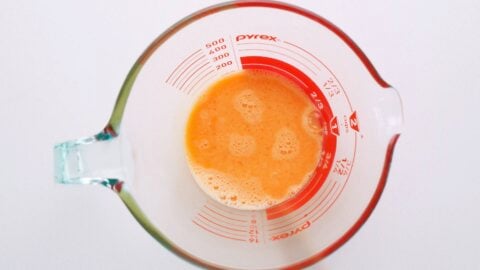
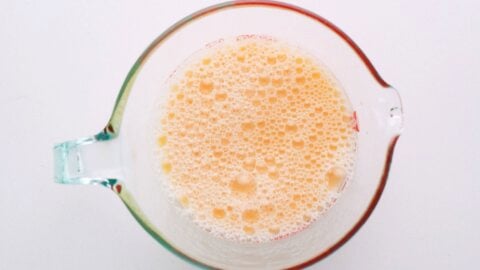
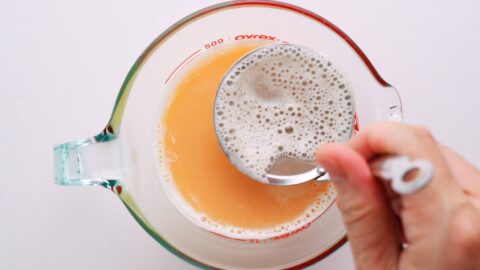
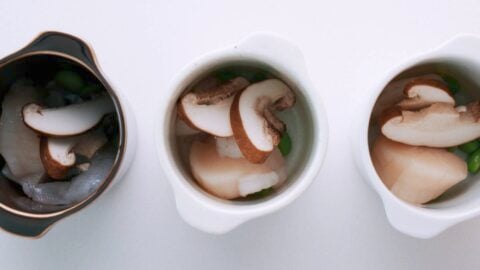
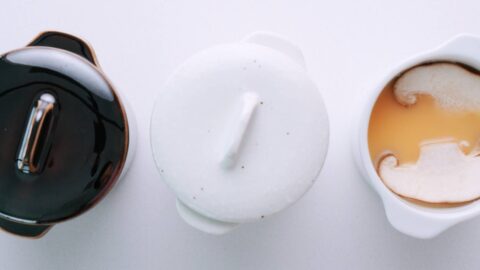
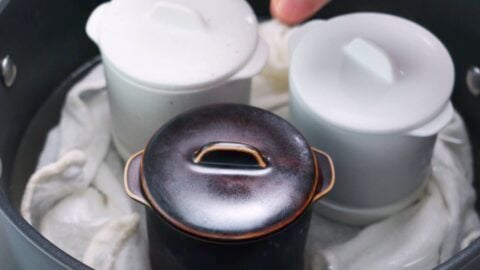
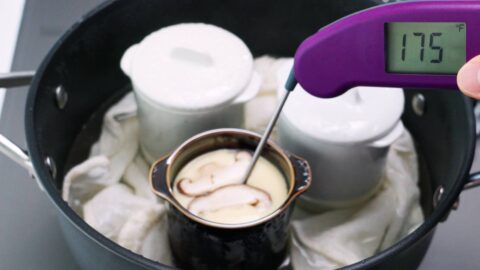
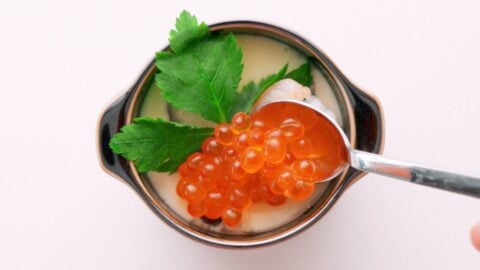
Maddie says
The Chawanmushi itself turned out pretty good but the dish towel I put in the pot ended up catching fire and ruining my brand new cuisinart pot and filling my house with smoke. Do not put a dish towel in the pot like the recipe calls for.
Marc Matsumoto says
Hi Maddie, I'm sorry to hear that happened to you. Did you add water to the pot as explained in the instructions? It should not be possible for the towel to catch on fire as long as it is soaking in water.
Kathy Stroup says
Shopping for cups to make this right now. Yours are beautiful and more my style than most of the ones I've found. It seems to me that if the lid doesn't lap over the side of the vessel, moisture from the steam bath could enter. Or is that really an issue?
Since I started shopping for these, eggs have gone to $7 a dozen here. They're going to deserve fancier treatment at that price!
Marc Matsumoto says
Hi Kathy, yes it helps to have the lid overhang the lip so you don't end up with water inside the cups. There are other ways to control for this though, like you can stick a wet towel between the lid and the pot to catch any dripping condensation. Probably not worth paying the shipping but I got these on Amazon: https://www.amazon.co.jp/%E3%83%86%E3%83%BC%E3%83%96%E3%83%AB%E3%82%A6%E3%82%A7%E3%82%A2%E3%82%A4%E3%83%BC%E3%82%B9%E3%83%88-%E5%92%8C%E3%82%AB%E3%83%95%E3%82%A7%E3%82%B9%E3%82%BF%E3%82%A4%E3%83%AB-%E3%82%B8%E3%83%A3%E3%83%9D%E3%83%8D%E3%82%B3%E3%82%B3%E3%83%83%E3%83%88%E8%93%8B%E4%BB%98%E3%81%8D-3%E8%89%B2%E3%82%BB%E3%83%83%E3%83%88-%E3%82%B9%E3%83%BC%E3%83%97%E3%82%AB%E3%83%83%E3%83%97/dp/B07QWP5P33/ref=sr_1_4_sspa?crid=3DL0UGM6BO8UH&keywords=%E8%8C%B6%E7%A2%97%E8%92%B8%E3%81%97+%E9%A3%9F%E5%99%A8&qid=1675047566&sprefix=chawanmushi%2Caps%2C150&sr=8-4-spons&psc=1&spLa=ZW5jcnlwdGVkUXVhbGlmaWVyPUFPSVROSTRDMTAyN0omZW5jcnlwdGVkSWQ9QTAxNzQ3NTJWSVdVR0hNNVdWSTgmZW5jcnlwdGVkQWRJZD1BMVA0RVlRWVBUWTJISyZ3aWRnZXROYW1lPXNwX2F0ZiZhY3Rpb249Y2xpY2tSZWRpcmVjdCZkb05vdExvZ0NsaWNrPXRydWU=
BTW, the egg prices in the US have even hit the news here in Japan.
Tynd says
Are the stock and egg supposed to separate on steaming?? Did I have the water too hot perhaps? Any tips for avoiding this result would be appreciated. It still tasted good!
Marc Matsumoto says
Hi Tynd the stock and egg should not seperate. This usually happens when the egg is overcooked. This can be because you have the heat up too high, or you've left the cups in the steamer for too long. Did you check the temperature of the custard with a thermometer? If you haven't already, give the video a watch, which shows the setup (you want to get the water up to a boil before you add the cups, but after you add them it should be at a bare simmer). I hope that helps.
YLK says
Made CHAWANMUSHI today with some modifications (cut recipe in half for solo breakfast, no salt, just used a dollop of Okonomi dipping sauce at the bottom of serving bowl). So delicious !! Thanks for this website/recipes !!
Marc Matsumoto says
You're welcome, I'm glad to hear you enjoyed it!
YLK says
Made CHAWANMUSHI with lobster, diced asparagus and shitake mushroom. The BOMB !!
Marc Matsumoto says
I bet! Great idea using lobster!
Joey says
Hi, can I steam them on the steamer rack instead of putting them into the water bath? What difference will these 2 methods produce? Thanks!
Marc Matsumoto says
Hi Joey, yes a steamer will work. The waterbath method is just easier for most people since anyone should have a pot, but not everyone has a steamer.